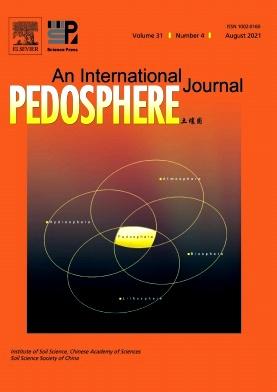在蔬菜轮作系统中,五年控释/稳定氮肥可减少田间氮素流失,同时不增加二氧化碳排放
IF 7.3
2区 农林科学
Q1 SOIL SCIENCE
引用次数: 0
摘要
控释/稳定氮肥可以提高蔬菜产量,减少温室气体排放,实现经济高效、环保的蔬菜生产。然而,长期固定位置轮作蔬菜田控释/稳定施氮的研究有限。通过5年的田间试验,研究了长期控释/稳定施氮在减少温室气体排放和提高生菜产量方面的作用。施氮采用6种不同处理:控制没有氮肥(CK),正常当地农业实践应用尿素400公斤N农业(T1)、优化应用尿素320公斤N农业(T2)、优化应用尿素320公斤N是补充的1.0公斤是3,4-dimethylpyrazole磷酸(DMPP) N抑制剂(T3),应用polyurethane-coated尿素320公斤N农业(T4)和应用polyurethane-coated尿素320公斤N是补充的1.0公斤是DMPP (T5)。结果表明:与T2处理相比,施用控释/稳定氮肥的T3、T4和T5处理年均氮氧化物(N2O)排放量减少12.2% ~ 56.7%,二氧化碳(CO2)排放量减少1.31% ~ 10.0%;T4和T5处理的氮氧化物和CO2排放量明显低于T3处理。N2O和CO2排放未观察到显著的季节或年际变化。观测到的现象归因于土壤铵态氮和硝态氮含量的波动。本研究结果表明,长期控释/稳定施氮减少了田间氮损失,在不增加CO2排放的情况下有利于蔬菜产量,突出了该技术在农业可持续生产中的应用潜力。本文章由计算机程序翻译,如有差异,请以英文原文为准。
Five-year controlled-release/stable nitrogen fertilization reduces field nitrogen loss without increasing carbon dioxide emissions in a vegetable rotation system
Controlled-release/stable nitrogen (N) fertilizers can improve vegetable yields and achieve lower greenhouse gas emissions, resulting in cost-effective and environmentally friendly vegetable production. However, there has been limited research on the controlled-release/stable N fertilization in long-term fixed-position vegetable rotation fields. In this study, a five-year field experiment was conducted to examine the effects of long-term controlled-release/stable N fertilization in reducing greenhouse gas emissions and increasing lettuce yield. Six distinct treatments were employed for N fertilization: the control without N fertilizer (CK), normal local farming practices with application of urea fertilizer at 400 kg N ha-1 (T1), optimized application of urea at 320 kg N ha-1 (T2), optimized application of urea at 320 kg N ha-1 with supplementation of 1.0 kg ha-1 3,4-dimethylpyrazole phosphate (DMPP) as N inhibitor (T3), application of polyurethane-coated urea at 320 kg N ha-1 (T4), and application of polyurethane-coated urea at 320 kg N ha-1 with supplementation of 1.0 kg ha-1 DMPP (T5). The results showed that the T3, T4, and T5 treatments using controlled-release/stable N fertilization emitted about 12.2%–56.7% less average annual cumulative nitrous oxide (N2O) and 1.31%–10.0% less carbon dioxide (CO2) than the T2 treatment. Nitrous oxide and CO2 emissions from the T4 and T5 treatments were considerably lower than those from the T3 treatment. No significant seasonal or interannual variability was observed in N2O and CO2 emissions. The observed phenomena were attributed to the fluctuations in soil ammonium- and nitrate-N contents. The findings in this study revealed that long-term controlled-release/stable N fertilization resulted in reduced field N loss, benefitting vegetable yields without increasing CO2 emissions and highlighting the application potential of this technique for sustainable agricultural production.
求助全文
通过发布文献求助,成功后即可免费获取论文全文。
去求助
来源期刊

Pedosphere
环境科学-土壤科学
CiteScore
11.70
自引率
1.80%
发文量
147
审稿时长
5.0 months
期刊介绍:
PEDOSPHERE—a peer-reviewed international journal published bimonthly in English—welcomes submissions from scientists around the world under a broad scope of topics relevant to timely, high quality original research findings, especially up-to-date achievements and advances in the entire field of soil science studies dealing with environmental science, ecology, agriculture, bioscience, geoscience, forestry, etc. It publishes mainly original research articles as well as some reviews, mini reviews, short communications and special issues.
 求助内容:
求助内容: 应助结果提醒方式:
应助结果提醒方式:


